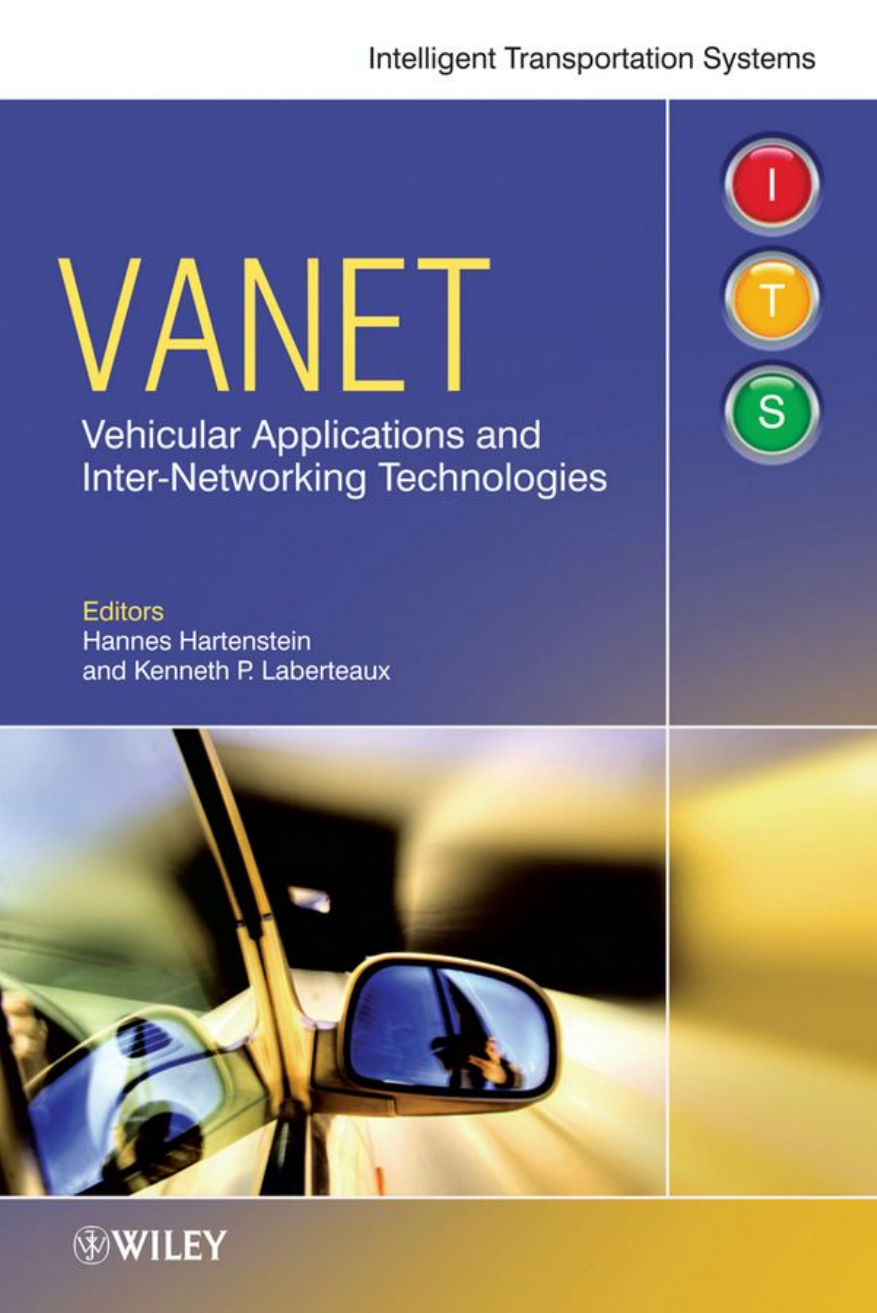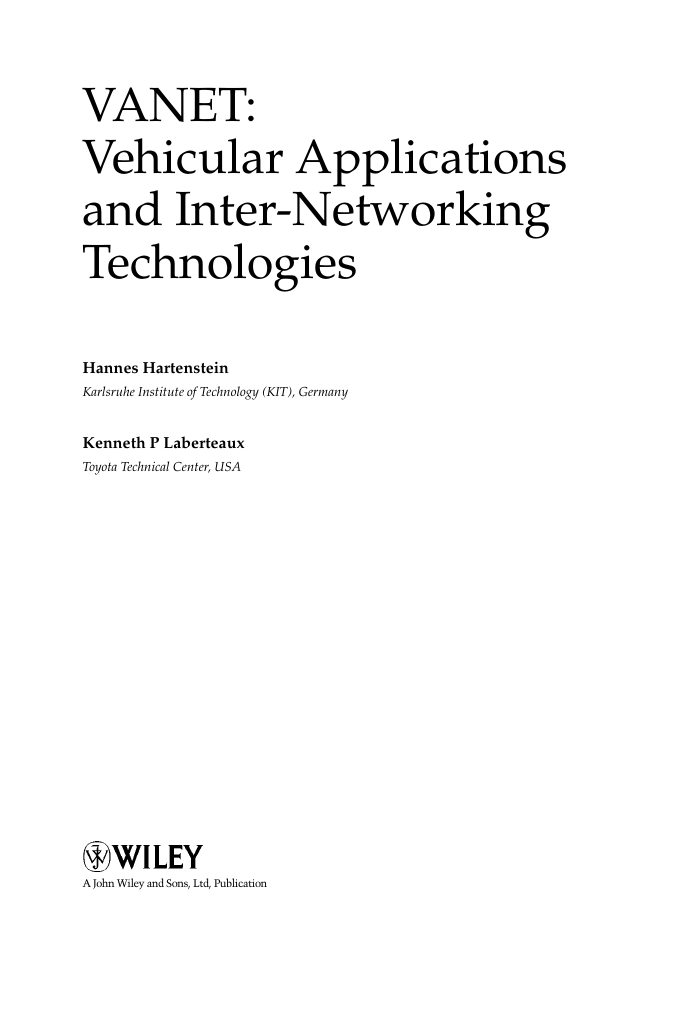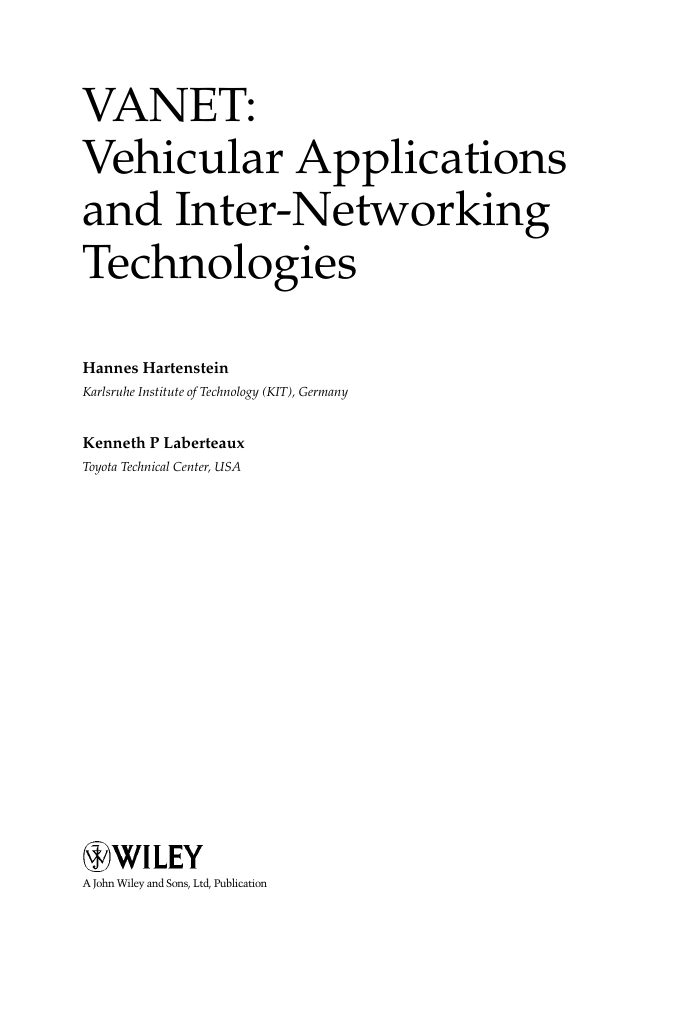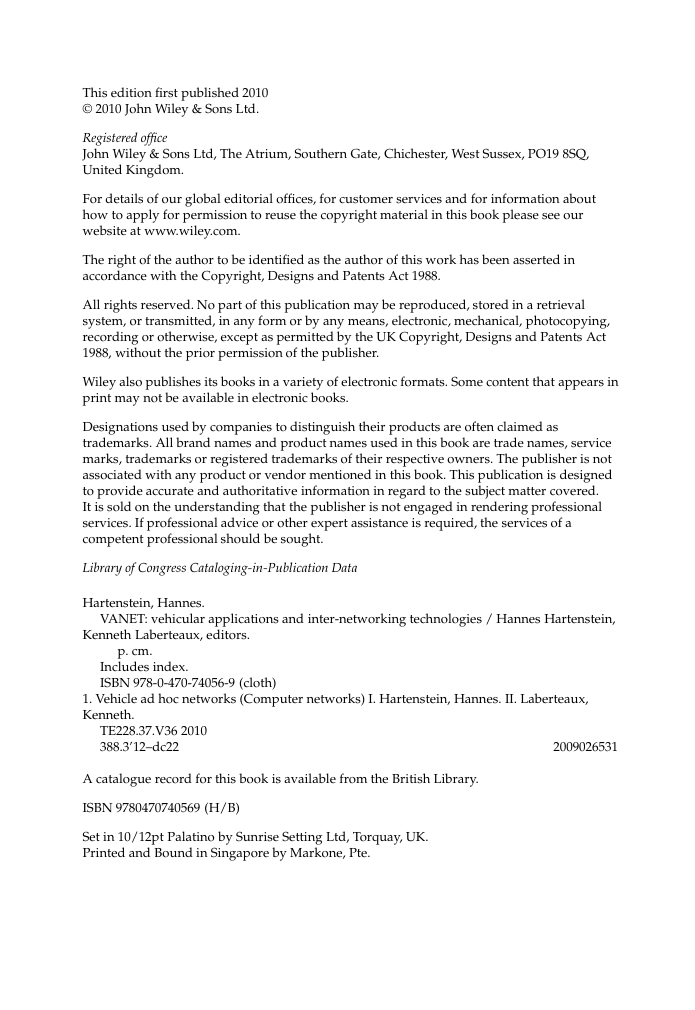Contents
Foreword
About the Editors
Preface
Acknowledgments
List of Contributors
1 Introduction
1.1 Basic Principles and Challenges
1.2 Past and Ongoing VANET Activities
1.2.1 From the beginning to the mid 1990s
1.2.2 From the mid 1990s to the present
1.2.3 Examples of current project results
1.3 Chapter Outlines
References
2 Cooperative Vehicular Safety Applications
2.1 Introduction
2.1.1 Motivation
2.1.2 Chapter outline
2.2 Enabling Technologies
2.2.1 Communication requirements
2.2.2 Vehicular positioning
2.2.3 Vehicle sensors
2.2.4 On-board computation platforms
2.3 Cooperative System Architecture
2.4 Mapping for Safety Applications
2.4.1 Non-parametric path prediction
2.4.2 Parametric path prediction
2.4.3 Stochastic path prediction
2.5 VANET-enabled Active Safety Applications
2.5.1 Infrastructure-to-vehicle applications
2.5.2 Vehicle-to-vehicle applications
2.5.3 Pedestrian-to-vehicle applications
References
3 Information Dissemination in VANETs
3.1 Introduction
3.2 Obtaining Local Measurements
3.3 Information Transport
3.3.1 Protocols for information transport
3.3.2 Improving network connectivity
3.3.3 What to transport
3.4 Summarizing Measurements
3.5 Geographical Data Aggregation
3.6 Conclusion
References
4 VANET Convenience and Efficiency Applications
4.1 Introduction
4.2 Limitations
4.2.1 Capacity
4.2.2 Connectivity
4.2.3 Competition
4.3 Applications
4.4 Communication Paradigms
4.4.1 Centralized client/server systems
4.4.2 Infrastructure-based peer-to-peer communication
4.4.3 VANET communication
4.5 Probabilistic, Area-based Aggregation
4.5.1 FM sketches
4.5.2 Using sketches for data aggregation in VANETs
4.5.3 Soft-state sketches
4.5.4 Forming larger area aggregates
4.5.5 Application study
4.6 Travel Time Aggregation
4.6.1 Landmark-based aggregation
4.6.2 Judging the quality of information
4.6.3 Hierarchical landmark aggregation
4.6.4 Evaluation
4.7 Conclusion
References
5 Vehicular Mobility Modeling for VANET
5.1 Introduction
5.2 Notation Description
5.3 Random Models
5.4 Flow Models
5.4.1 Microscopic flow models
5.4.2 Macroscopic flow models
5.4.3 Mesoscopic flow models
5.4.4 Lane changing models
5.4.5 Intersection management
5.4.6 Impact of flow models on vehicular mobility
5.5 TrafficModels
5.5.1 Trip planning
5.5.2 Path planning
5.5.3 Influence of time
5.5.4 Impact of traffic models on vehicular mobility
5.6 BehavioralModels
5.7 Trace or Survey-based Models
5.8 Integration with Network Simulators
5.8.1 Network simulators
5.8.2 Isolated mobility models
5.8.3 Embedded mobility models
5.8.4 Federated mobility models
5.8.5 Application-centric versus network-centric simulations
5.8.6 Discussion
5.9 A Design Framework for Realistic Vehicular Mobility Models
5.9.1 Motion constraints
5.9.2 Traffic generator
5.9.3 Application-based level of realism
5.10 Discussion and Outlook
5.11 Conclusion
References
6 Physical Layer Considerations for Vehicular Communications
6.1 Standards Overview
6.1.1 A brief history
6.1.2 Technical alterations and operation
6.2 Previous Work
6.3 Wireless Propagation Theory
6.3.1 Deterministic multipath models
6.3.2 Statistical multipath models
6.3.3 Path loss modeling
6.4 Channel Metrics
6.4.1 Delay spread
6.4.2 Coherence bandwidth
6.4.3 Doppler spread
6.4.4 Coherence time
6.4.5 Impact on OFDM systems
6.5 Measurement Theory
6.6 Empirical Channel Characterization at 5.9 GHz
6.6.1 Highway environments
6.6.2 Urban environments
6.6.3 Rural LOS environments
6.6.4 Results summary
6.6.5 Analysis
6.7 Future Directions
6.8 Conclusion
6.9 Appendix: Deterministic Multipath Channel Derivations
6.9.1 Complex baseband channel representation – continuous time
6.9.2 Complex baseband channel representation – discrete time
6.10 Appendix: LTV Channel Response
6.11 Appendix: Measurement Theory Details
6.11.1 PN sequence bits
6.11.2 Generation of LTI channel estimates
6.11.3 Generation of Ricean K-factor estimates
References
7 MAC Layer and Scalability Aspects of Vehicular Communication Networks
7.1 Introduction: Challenges and Requirements
7.2 A Survey on Proposed MAC Approaches for VANETs
7.2.1 Time-division multiple access based approaches
7.2.2 Space-division multiple access based approaches
7.2.3 Code-division multiple access based approaches
7.3 Communication Based on IEEE 802.11p
7.3.1 The IEEE 802.11 standard
7.3.2 IEEE 802.11p: towards wireless access in vehicular environments
7.3.3 Modeling and simulation of IEEE 802.11p-based networks
7.4 Performance Evaluation and Modeling
7.4.1 Performance results of IEEE 802.11p-based active safety communications
7.4.2 Computational costs of simulation
7.4.3 Analytical models for performance of IEEE 802.11 networks
7.4.4 An empirical model for performance of IEEE 802.11p networks
7.4.5 Conclusion
7.5 Aspects of Congestion Control
7.5.1 The need for congestion control
7.5.2 Congestion control by means of transmit power control
7.5.3 Congestion control by means of rate control
7.6 Open Issues and Outlook
References
8 Efficient Application Level Message Coding and Composition
8.1 Introduction to the Application Environment
8.1.1 Safety applications and data requirements
8.1.2 Desirable architectural features
8.1.3 Broadcast characteristics
8.2 Message Dispatcher
8.2.1 Data element dictionary
8.2.2 Message construction
8.2.3 What and when to send
8.3 Example Applications
8.3.1 Emergency brake warning
8.3.2 Intersection violation warning
8.3.3 Message composition
8.3.4 Implementation
8.3.5 Analysis
8.4 Data Sets
8.5 Predictive Coding
8.5.1 Linear predictive coding
8.5.2 System model
8.5.3 Tolerable error
8.5.4 Predictive coding transmission policies
8.5.5 Predictive coding results
8.6 Architecture Analysis
8.7 Conclusion
References
9 Data Security in Vehicular Communication Networks
9.1 Introduction
9.1.1 Outline
9.1.2 State of the art
9.2 Challenges of Data Security in Vehicular Networks
9.3 Network, Applications, and AdversarialModel
9.3.1 Network model
9.3.2 Applications model
9.3.3 Attacker model
9.4 Security Infrastructure
9.4.1 Cryptography services
9.4.2 Key management
9.5 Cryptographic Protocols
9.5.1 Certificate verification
9.5.2 Encryption
9.5.3 Key agreement
9.5.4 Authentication
9.5.5 Secure positioning
9.5.6 Identification of misbehaving nodes
9.5.7 Summary
9.6 Privacy Protection Mechanisms
9.6.1 Properties
9.6.2 Key assignment
9.6.3 Tracking vehicles
9.6.4 Evaluation
9.7 Implementation Aspects
9.7.1 Cryptographic schemes and key length
9.7.2 Physical security
9.7.3 Organizational aspects
9.7.4 Update of software and renewal of certificates
9.8 Outlook and Conclusions
References
10 Standards and Regulations
10.1 Introduction
10.2 Layered Architecture for VANETs
10.2.1 General concepts and definitions
10.2.2 A protocol stack for DSRC
10.3 DSRC Regulations
10.3.1 DSRC in the United States
10.3.2 DSRC in Europe
10.4 DSRC Physical Layer Standard
10.4.1 OFDM physical medium dependent (PMD) function
10.4.2 OFDM physical layer convergence procedure (PLCP) function
10.5 DSRC Data Link Layer Standard (MAC and LLC)
10.5.1 Medium access control (MAC) sublayer
10.5.2 Logical link control (MAC) sublayer
10.6 DSRCMiddle Layers
10.6.1 MAC extension for multi-channel operation: IEEE 1609.4
10.6.2 Network services for DSRC: network and transport layers, IEEE 1609.3
10.6.3 WSA length summary
10.6.4 Middle layer security: IEEE 1609.2
10.7 DSRCMessage Sublayer
10.7.1 SAE J2735 DSRC message sets
10.7.2 Case study: The basic safety message
10.7.3 Case study: The probe vehicle data message
10.7.4 Case study: The roadside alert message
10.8 Summary
10.9 Abbreviations and Acronyms
References
Index
















 2023年江西萍乡中考道德与法治真题及答案.doc
2023年江西萍乡中考道德与法治真题及答案.doc 2012年重庆南川中考生物真题及答案.doc
2012年重庆南川中考生物真题及答案.doc 2013年江西师范大学地理学综合及文艺理论基础考研真题.doc
2013年江西师范大学地理学综合及文艺理论基础考研真题.doc 2020年四川甘孜小升初语文真题及答案I卷.doc
2020年四川甘孜小升初语文真题及答案I卷.doc 2020年注册岩土工程师专业基础考试真题及答案.doc
2020年注册岩土工程师专业基础考试真题及答案.doc 2023-2024学年福建省厦门市九年级上学期数学月考试题及答案.doc
2023-2024学年福建省厦门市九年级上学期数学月考试题及答案.doc 2021-2022学年辽宁省沈阳市大东区九年级上学期语文期末试题及答案.doc
2021-2022学年辽宁省沈阳市大东区九年级上学期语文期末试题及答案.doc 2022-2023学年北京东城区初三第一学期物理期末试卷及答案.doc
2022-2023学年北京东城区初三第一学期物理期末试卷及答案.doc 2018上半年江西教师资格初中地理学科知识与教学能力真题及答案.doc
2018上半年江西教师资格初中地理学科知识与教学能力真题及答案.doc 2012年河北国家公务员申论考试真题及答案-省级.doc
2012年河北国家公务员申论考试真题及答案-省级.doc 2020-2021学年江苏省扬州市江都区邵樊片九年级上学期数学第一次质量检测试题及答案.doc
2020-2021学年江苏省扬州市江都区邵樊片九年级上学期数学第一次质量检测试题及答案.doc 2022下半年黑龙江教师资格证中学综合素质真题及答案.doc
2022下半年黑龙江教师资格证中学综合素质真题及答案.doc